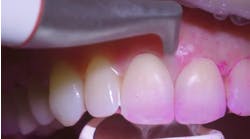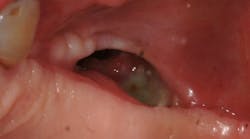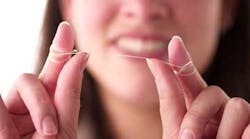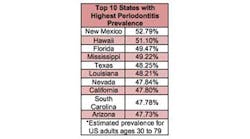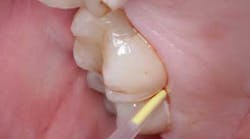Marijuana use linked to increased risk for periodontal disease
Researchers have found that frequent recreational cannabis use—including marijuana, hashish, and hash oil—may be associated with an increased risk of periodontal disease.
Researchers have found that frequent recreational cannabis use—including marijuana, hashish, and hash oil—may be associated with an increased risk of periodontal disease. When compared to study participants who used cannabis less regularly, those who had used it at least once a month for a year demonstrated increased indicators of mild, moderate, and severe periodontal disease. The study is featured in the American Academy of Periodontology's Journal of Periodontology.
In the report, titled “Relationship Between Frequent Recreational Cannabis (Marijuana and Hashish) Use and Periodontitis in Adults in the United States: NHANES 2011-2012,” participants who identified themselves as frequent users of recreational cannabis demonstrated an average of 29.2 sites around the teeth with periodontal pocket depths of greater than or equal to 4 mm; 24.8 sites with pocket depth of greater than or equal to 6 mm; and 24.5 sites with at least 8 mm of pocket depth. Study participants who reported to less frequent cannabis use indicated an average of 22.3, 19.2, and 18.9 sites respectively.
READ MORE |Study identifies genes that cause periodontal disease
Pocket depths are critical indicators of periodontal disease, measuring the space between a tooth and surrounding gum tissue. Healthy attachment of gum tissue, which should fit snuggly around a tooth, measures between 1 mm to 3 mm in depth. Pocket depth measurements indicative of disease can range between 3 mm to 5 mm deep (mild periodontal disease) to more than 7 mm deep (severe periodontal disease).
“At a time when the decriminalization of marijuana use is becoming more common in the United States, users should be made aware of the impact that any form of cannabis can have on the health of their gums,” says Dr. Terrence J. Griffin, president of the American Academy of Periodontology (AAP). “There are a number of risk factors that contribute to the development of periodontal disease, and this report suggests that cannabis use may be one of them. Patients should notify their periodontists of all known risk factors to ensure timely diagnosis and appropriate treatment.”
Data for this report—which assessed a nationally representative sample of US adults between ages 30 and 59—were collected as part of the National Health and Nutrition Examination Survey (2011-2012), administered by the Centers for Disease Control and Prevention (CDC) in collaboration with the AAP. The AAP and the CDC have worked together since 2003 to determine periodontitis prevalence in the United States, finding that nearly half of all US adults age 30 and above have some form of periodontal disease.
READ MORE | The new street drugs some of your patients may be using that you have never heard of
Periodontal disease is caused by an inflammatory reaction to a bacterial infection below the gumline, and it can lead to swelling, irritation, receding gums, and tooth loss if left untreated. The AAP recommends regular flossing, brushing twice a day, and undergoing yearly comprehensive periodontal evaluations for the prevention of periodontal disease, which is treatable and often reversible with proper and timely care from a periodontist.
“Those who suspect they have gum disease should schedule an appointment with a local periodontist,” Dr. Griffin says.
To learn more about periodontal disease or to find a periodontist in your area, visit perio.org.
Read more about periodontal disease by visiting the Perio-Implant Advisory website.
The American Academy of Periodontology (AAP) represents more than 8,000 periodontists—specialists in the prevention, diagnosis, and treatment of inflammatory diseases affecting the gums and supporting structures of the teeth, and in the placement of dental implants. Periodontics is one of the nine dental specialties recognized by the American Dental Association.

